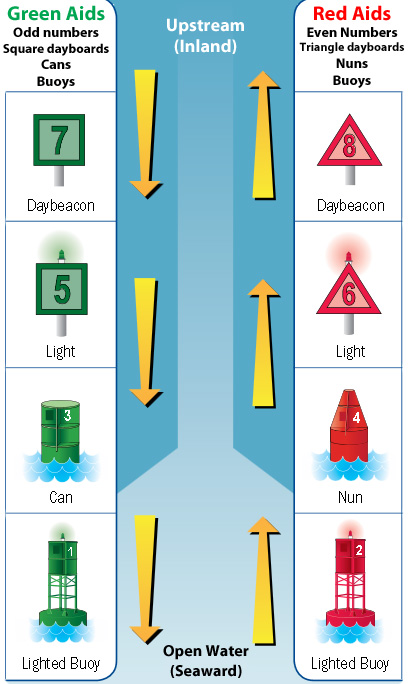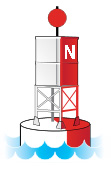
Every boater on the water should be able to read and understand colored navigational aids. Knowing what these aids mean is very important to the safety of everyone on the water.

According to the Boating Safety Resource Center, there were 651 deaths in 4,515 U.S. boating accidents in 2012. Another 3,000 were injured. Of those, 13 deaths and 236 injuries were caused by navigation rules violation.
By understanding the basic markings of navigational aids in the waterway, boaters can make sure time on the water is fun as it should be.
These green and red navigational aids that could be seen on waterways include buoys, beacons (daybeacons), cans and nuns.
Understanding Colors
Red marked navigational aids should be on the right side (starboard) of the boat when returning FROM open water. Red markers will have even numbers and should increase as the boater moves inland. Helpful tip: "Red, Right, Returning."
Green marked aids should be on the right side (starboard) of the boat when traveling TOWARD open water. Green markers will have odd numbers and will decrease as the boater moves toward open water.
If there are no markers, navigate clockwise around landmasses, according to the U.S. Coast Guard.
Preferred Channel Marker

If an aid has a combination of red and green, it notes a preferred channel. The top color of the marker indicates how a boater should treat the navigation. (If the top color is red, it is considered a red marker and vice versa.)
Safe Water Marker

These aids mark fairways, mid-channels and offshore approach points, according to the U.S. Coast Guard. They have white and red vertical stripes and could be in a variety of shapes (spherical, cans or buoys), have lights, contain letters and have a red topmark. This marker indicates it is safe to pass on either side but it should be kept to the port (left) side of the boat when moving upstream or downstream.
To watch a short video on How to Read Water Buoys and Markers from Boat-ed.com, click here.
- 5161 views

